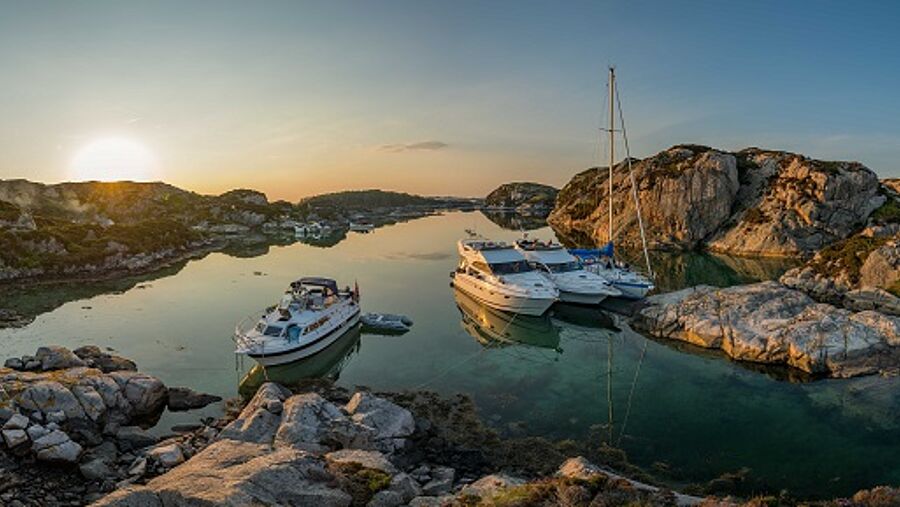Anchoring, how to make it go smoothly...
Whether for a short swim, one night or several days, every year a large number of boaters drop anchor close to our shores. Contrary to what one might think, anchoring is a delicate manoeuvre that requires special attention. Of course, the safety of those onboard is at stake, but it is not just that: our seabed is significantly impacted by the overcrowding of our coastline, such that anchoring is now at the centre of the debate. Safety, comfort, ecology...here are some rules and advice that will help you anchor safely and minimize your impact on marine life. Mooring requires an analysis of your environment and respecting some basic rules.

Choose the right anchorage location
- This appears obvious, but it is best to choose a sheltered spot. As well as the comfort of passengers, it is important to avoid putting your anchorage to the test of currents, tides or wind.
- Evaluate the depth to determine the chain length to be used (approximately 3 to 4 times the depth depending on the type of anchor used).
- Check that you have enough space to turn without obstructing traffic or risk hitting other boats at anchor
- Choose an anchor suited to the seabed at your location. Indeed, not all anchors are equal, consider whether you are anchored on a rocky, sandy bottom or on a seaweed bed.
Safety and security
Most sailors may forget that handling the anchor has associated risks and accidents are frequent. Remember to wear shoes and gloves to protect your hands. Once the boat is at anchor, always remember to lower the ladder. If you are alone on board and accidentally fall into the water, this precaution could really help you.
What to do on the water
Once the anchorage location has been selected:
- Go slowly and head your boat up into the wind (or current).
- Bring the boat to a standstill in order to let the anchor drop vertically.
- Once the anchor is at the bottom, let the boat drift so that the anchor can take hold. If there is no wind or current, use reverse gear.
- Using a fixed landmark or possibly your GPS, check that your anchorage is stable and that the anchor is not slipping. If you are staying on anchor for longer, remember to check this regularly.
- Your position at anchor must be easily identifiable from other users, so you must:
By day: use a black mooring buoy
At night: have a white light visible at 360°
Mooring and Ecology.
For the seabed, the beauty of our coastline is a curse.
Indeed, the ever-increasing number of boats dropping anchor near our shores has a real impact on flora and fauna.
In recent years, seaweed beds have been in sharp decline. Yet they are an essential part of the ecosystem. More than a shelter for wildlife, it is also a vital source of food and oxygen for many species.
Boaters may not be aware of this, but when a boat drops anchor in the middle of these underwater meadows, the damage can be catastrophic. Slowly slipping anchors dig deep furrows. As most of these species grow slowly, in nature it takes several decades to repair this damage.
In the Mediterranean, it is Posidonia that concerns us. This endemic plant (which is not an algae, but a flowering plant) is seriously damaged by anchors, especially by superyachts around the Côte d'Azur.
To address this problem, the Mediterranean Maritime Prefecture (France) signed an order on 3 June to tighten up the regulations on the protection of the seabed. This order aims to redefine protected areas and increase penalties for non-compliance. Even if this mainly concerns boats over 24 metres in length, all boaters are asked to be vigilant.
Choosing the right anchor
Each type of anchor has its own characteristics and not all types are necessarily suitable for all seabeds:
- Flat anchors
These are more suitable for loose surfaces such as sandy or muddy sea bottoms. On the other hand, they tend to tip to the side and drift. - Fluked anchors
These are more versatile and have a better hold than the flat anchor. They use the momentum of the boat to stay in place. It is the most commonly used anchor type. - Spade anchors
This is the type of anchor that offers the best hold. They sink in case of heavy load and have the ability to re-grip easily in case of drifting. However, they require a fairly long chain length. - Grapnel anchors
Well-adapted to algae and rocky bottoms, they are used for fishing (i.e. when a person remains on board) or for tenders.
